Understanding Edge Computing
In recent years, the technology landscape has seen a dramatic shift towards edge computing, a paradigm that processes data closer to the source of generation rather than relying solely on centralized cloud servers. This shift is particularly significant for latency sensitive applications which require immediate data processing and response. By minimizing the distance data must travel, edge computing effectively reduces latency, enhances performance, and supports real-time operations.
The Importance of Latency in Applications
Latency refers to the time taken for data to travel from its source to its destination and back again. In many applications, particularly those that require real-time data processing, high latency can lead to performance bottlenecks and suboptimal user experiences. Examples of latency sensitive applications include:
- Video Streaming: Platforms like Netflix and YouTube depend on low latency to provide buffering-free content delivery.
- Online Gaming: A delay of just a few milliseconds can significantly affect gameplay, making edge computing crucial for gamers.
- Autonomous Vehicles: These rely on real-time data from various sensors, making any delay in processing potentially dangerous.
- Healthcare Monitoring: Devices that track patient vitals need instantaneous updates to prevent emergencies.
How Edge Computing Reduces Latency
Edge computing reduces latency in several key ways:
1. Proximity to Data Sources
By processing data near the source, edge devices reduce the distance data must travel. This is crucial for applications that require immediate feedback and decision-making.
2. Bandwidth Optimization
With edge computing, only the most relevant data is sent to the cloud for further analysis, minimizing bandwidth usage. This is particularly advantageous for IoT devices that generate massive amounts of data.
3. Localized Processing
Edge devices can handle computations locally, allowing them to react instantly to changing conditions without waiting for data to be transmitted to a remote server.
4. Network Reliability
Edge computing mitigates reliance on centralized data centers, providing more reliable connections. In cases where the central server is unreachable, edge devices can continue functioning independently.
Real-World Applications of Edge Computing
Numerous industries are leveraging edge computing to enhance the performance of latency sensitive applications:
Smart Cities
In smart cities, edge computing is utilized to manage traffic flow, monitor public transportation, and enhance security through real-time surveillance. For example, traffic lights equipped with edge computing can adjust their cycles based on live traffic data, reducing congestion.
Manufacturing
In manufacturing, edge computing allows factories to monitor machinery and equipment in real time, facilitating predictive maintenance and minimizing downtime. For example, sensors placed on equipment can alert operators before potential failures, ensuring seamless operations.
Retail
Retailers use edge computing to personalize customer experiences by analyzing data from in-store sensors and devices. This allows for targeted marketing strategies and improved inventory management, directly impacting the bottom line.
Future Predictions for Edge Computing
As technology continues to advance, the role of edge computing in latency sensitive applications is expected to grow. With the proliferation of IoT devices and the increasing demand for real-time data processing, edge computing will become a standard practice across multiple industries. Future predictions include:
- More Devices at the Edge: As more devices connect to the internet, the need for edge computing will increase. This includes everything from smart home devices to industrial sensors.
- Increased Automation: Edge computing will facilitate greater automation in various sectors, allowing for faster decision-making and minimizing human intervention.
- Enhanced Security: Processing data at the edge can improve security by reducing the amount of sensitive data sent over networks.
Pros and Cons of Edge Computing
Pros
- Reduced Latency: By processing data closer to its source, edge computing significantly lowers latency.
- Improved Performance: Applications can operate more efficiently with faster response times.
- Bandwidth Savings: Reducing the amount of data sent to the cloud can lower costs and improve network efficiency.
Cons
- Complexity: Managing a distributed network of edge devices can be more complex than a centralized approach.
- Security Challenges: More endpoints can mean more vulnerabilities if not managed properly.
- Initial Investment: Setting up edge computing infrastructure can require significant investment.
Conclusion
Edge computing stands as a revolutionary development in the realm of technology, especially for latency sensitive applications. By bringing computation closer to the data source, businesses can enhance performance, reduce latency, and create more efficient systems. As industries continue to evolve and the demand for real-time data processing grows, edge computing will undoubtedly play a pivotal role in shaping the future of technology.

